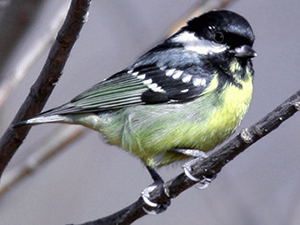
Recorded for the first time in the Republic of Korea in November 2002, the Light-vented (or “Chinese”) Bulbul Pycnonotus sinensis has now been recorded on at least ten islands in the West Sea and as far east as Busan; it has bred on at least two islands (first in 2004); and it has over-wintered in Suncheon, on Heuksan Island and on Gageo Island. It is one of several species that now appear to be colonizing Korea from the west and southwest. Other such species include the Chinese Blackbird Turdus (merula) mandarinus (first recorded in Korea in 1999, when nesting), the Red-billed Starling Sturnus sericeus (first recorded in 2000, and first confirmed breeding in 2007), the Plumbeous Water Redstart Rhyacornis fuliginosa (first recorded in 2006, and first found breeding in 2007, with probably eight records in 2008 alone) and the Yellow-bellied Tit Periparus venustulus (first found in 2005, and now with records from Socheong Island in the northwest, to Heuksan and Jindo in the southwest, and Busan in the south-east).

While still rare in Korea, why are these species increasing, while so many other more widespread species seem to be decreasing? While data in many cases remain too poor to identify exact trends and causes, at least part of the reason is probably the changing climate.
Since 1912, the mean annual temperature in the Republic of Korea has risen between 0.9 C and 1.5 C (Lim, 2008), with mean annual temperatures rising 0.23 C per decade since the 1950s (Jung et al., 2002). One climate model even appears to suggest that mean temperatures could rise much more quickly this century (by about 5.5°C between 1971-2000 and the period 2071-2100), with increasing periods of extreme hot weather and heavy rain (Boo et al., 2006). Climate change has already been linked elsewhere to e.g. rising sea-levels, and to the availability, quantity and quality of shorebird habitats (Rehfisch & Austin, 2006); to changes in the frequency and distribution of snow and rain, and to shifts in the distribution of plants and insects (Lim, 2008); to earlier arrivals of some bird species in spring, and to a mismatch of some bird species’ breeding cycles and the insect populations on which they feed their young (Huppop & Huppop, 2008); and to milder winters, that allow an increasing number of species to winter north of their historic range (Audubon, 2009).
While some bird species might increase on a warmer Korean peninsula, others will not. Predictive models, matched by a growing body of field data, now reveal that this complex and rapid change is contributing to continent-wide declines in 75% of European bird species (Gregory et al., 2009).

Photo © Dr. Robin Newlin
Climate change is real, and it is already affecting biodiversity. The nation has again repeated its pledge to be an “early mover on climate change” (Canberra Times, March 4, 2009), and in February the Presidential Commission on Green Growth introduced measures to reduce CO2 emissions.
Such leadership is needed. More than a century ago it was commonly said that the Barn Swallow Hirundo rustica, then an abundant bird in Korea, came from the south on the third day of the third lunar month: approximately the middle of April (Campbell, 1892). By the middle of last century, Austin (1948) found them in Suwon by the end of March, and could cite an ornithologist who called this very numerous bird, “undoubtedly the most valuable bird in the country.” By the beginning of this century, the Barn Swallow while still common, has increasingly disappeared from many cities and towns.
This year, when the short winter yields to yet another early spring, when will the first Barn Swallows arrive? And what other changes might we also see in our birdlife?
References
- Audubon. 2009. BirdLife International Update at: http://www.birdlife.org/news/news/2009/02/american_cc.html
- Austin, O. L., Jr .1948. The Birds of Korea. Bull. Mus. Comp. Zool., Harvard Univ. 101: 1-301. (1972 reprint.)
- Boo K-O, Kwon W-T & Baek H-J. 2006. Change of extreme events of temperature and precipitation over Korea using regional projection of future climate change. Geophysical Research Letters. 2006, vol. 33, no1. Abstract at: http://cat.inist.fr/?aModele=afficheN&cpsidt=17511798 (Accessed March, 2009).
- Campbell, C. 1892. A List of Birds Collected in Corea. Ibis 1892, pp. 230-248.
- Canberra Times. 2009. South Korea President Calls for Bilateral Trade Boost. March 4, http://www.canberratimes.com.au/news/national/national/general/south-korean-president-calls-for-bilateral-trade-boost/1450294.aspx
- Gregory RD, Willis SG, Jiguet F, Vorísek P, Klvanová A, et al. 2009. An Indicator of the Impact of Climatic Change on European Bird Populations. PLoS ONE 4(3): e4678. doi:10.1371/journal.pone.0004678 Huppop, O. & K. Huppop. 2008. Climate changes and timing of bird migration. Pp. 17-37 in Proceedings of the 2nd International Symposium on Migratory Birds, 27 October 2008, Changwon, Korea. Published by Korea National Parks and Shinan County
- Jung H-S, Choi Y-E, Oh J-H & Lim G-H. 2002. Recent trends in temperature and precipitation over South Korea. International Journal of Climatology. At: http://www3.interscience.wiley.com/journal/98015404/abstract?CRETRY=1&SRETRY=0. (Accessed, March 2009).
- Lim J-H. 2008. Climate Change Impacts on Forest Ecosystems in Korea and Needs of Long-term Monitoring and Adaptation Activities. Pp. 3-12 in Proceedings of the 2nd International Symposium on Migratory Birds, 27 October 2008, Changwon, Korea. Published by Korea National Parks and Shinan County.
- Rehfisch, M. & G. Austin. 2006. Climate Change and Coastal Waterbirds: the United Kingdom experience reviewed. Pp. 398-404 In Boere, G., Galbraith,C. & D. Stroud. 2006. Waterbirds around the world. The Stationery Office, Edinburgh, UK. 960 pp.



